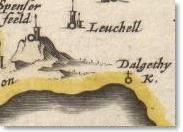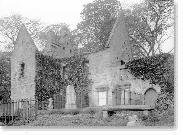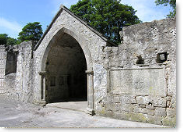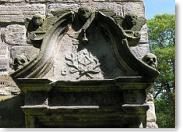The extensive remains of St Bridget's Church stand just above the shoreline at the head of Dalgety Bay, an inlet in the north shore of the Firth of Forth. The origins of St Bridget's Church date back the better part of 850 years. Granted by King William the Lion to the Priory of Inchholm, "The Church at Dalgetty with its appurtenances" was first mentioned in a Papal Bull written by Pope Alexander III declaring that the Church be founded. Appropriated at that time by Inchcolm, now an Abbey, the rebuild of the original church was consecrated in 1244 by David de Bernham, the Bishop of St. Andrews and dedicated to St Bridget, or Brigid, of Kildare in Ireland who lived from 451 to 525.
Dalgety Bay is a new town in the west of Fife, situated between Inverkeithing on the west and Aberdour to the east, and as the first private enterprise new town in Scotland, its origins go back a mere thirty odd years. However, as a place of human settlement, it goes back a very long way as recent archaeological excavations make only too plain.
The historical record, reconstituted from the evidence gleaned from buildings and structure and the written word, is also rich, since the parish of Dalgety in which the new town is located is an area with a long and fascinating history. Although today parishes are redundant in local government terms, they played until comparatively recent times a very important role as units of civil and ecclesiastical government. The "prehistory", of the new town of Dalgety Bay is accordingly, the story of the parish of Dalgety.
The village of Dalgety stood at the head of the coastal feature of Dalgety bay, but the ivy-clad ruins of the 12th century St. Bridget's Church, or Kirk, are all that now mark its site. When originally built St Bridget's would have been at the heart of the small community of Dalgety, serving in the latin-Catholic style, yet through the 17th century the chapel continued in use through the Reformation under the guidance of the Seton Earls of Dunfermline. There are still signs of the galleries that would once have helped the church accommodate the local population during the typically Presbyterian services of the day.
In terms of its population it was by no means an important parish, there being until the recent development of the new community of Dalgety Bay, no considerable town or other centre of population within its boundaries. Yet, within this small parish, there are quite a few places and features of considerable historic interest. The built heritage includes St Bridget's Church, the intriguingly distinctive former parish kirk, and several notable towers and historic mansions. The most striking of these remaining are the romantic old castle of Fordell and the now resuscitated Donibristle, the former seat of the Earls of Moray where in 1592 the Bonny Earl of ballad fame was foully slain.
In the aftermath of the Protestant Reformation of the mid sixteenth century the crown claimed most of the former church lands. In Morayshire, for example, new lordships were created out of the former ecclesiastical estates and granted, in part, to individuals who had rendered service to the king, a notable example being Alexander Seton, (1555-1622) who became Commendator of Pluscarden, Lord President of the Court of Session from 1593 to 1605, thereafter Lord Chancellor, and latterly 1st Earl of Dunfermline who was much respected for his great learning and judicial ability. The house and estate of "Dalgety Lodge" and it's church of St. Bridget's were acquired during his tenure at Dunfermline during the late 16th century, and became his private cottage-residence retreat. On 6 April 1611 Seton got a charter of novodamus of the lands and Baronies of Urquhart and Fyvie, the lands of Dalgety and Danduff, which were all incorporated into the Earldom of Dunfermline and lordships of Urquhart and Fyvie.
After the Reformation of 1560, three aisles were added on north and south, for the use of the local lairds, but it was Chancellor Seton who expanded the church as it is seen today, adding the barrel-vaulted tower-house or L-shaped wing, and the octagonal stair-tower, along with various other additions. Like the original town, unfortunately Dalgety Lodge and it's gardens are now long gone, however, within the chapel there remain many of the original interesting features: the Lairds loft, which remains accessible; a well-preserved 'piscina' by the altar - where a piscina is stone wash-basin for ritual rinsing of the communion chalice; and in the church grounds facing directly onto the shore, are a number of old gravestones and epitaphs including some from the 17th century with skull and crossbones or craft symbols like tailor's scissors. Gone however, are the old armorial panels of the Seton's.
In essence, St Bridget's is no more than a simple rectangular church, with no distinction between the nave and the chancel. This simple core was been added to on a number of occasions over the centuries, however, the end result is deceptively complex, looking from some angles less like a church, and more like a fairly upmarket house of the 1600s. There are the two burial isles: one on the north side of the church and another on the south side, all built for important local families, and there is a set of stone steps up the east end gable which gave access to the long since removed wooden gallery at that end of the church. The eastern end of the kirkyard has a "Mort house" where mourners used to keep watch on their deceased relatives to prevent grave robbers taking the bodies.
However, by far the most interesting of all is the two storey tower-house structure, almost like a miniature fortified tower house, attached to the west end of the church. This is the Dunfermline Aisle, built by Chancellor Seton as the Seton's of Dunfermline burial vault. This is in the ground floor, while the upper floor provided comfortable accommodation for the family, plus a private viewing window to allow them to benefit from the church service. The estate itself continued as the both the retreat and the traditional family burial grounds of this branch of the Seton family until James, 4th Earl of Dunfermline was attainted and the estate was forfeit in 1692.
Chancellor Seton, died at his residence at Pinkie House, Musselburgh, in June, 1622, and was buried at St. Bridget's in the family vault, with the following inscription, on a metal plate, on his coffin:
ALEXANDER SETONIUS, FERMELINODUNI COMES, SCOTIAE
CANCELLARIUS, OBIIT 66 ANNO AETATIS SUAE, 16 JULY 1622.
That is, " Alexander Seton, Earl of Dunfermline, and Chancellor of Scotland, died 16th July, 1622, aged 66 years. (See the Annals of Dunfermline. dates 1662 and 1820.). Buried in the Seton vault are: the Alexander Seton, 1st Earl of Dunfermline, his 1st wife Dame Lillias Drummond and his 2nd wife Countess Grizel Leslie; Charles Seton 2nd Earl of Dunfermline and his Countess Mary Douglas and her oldest son Charles, Lord Fyvie and Master of Dunfermline; and Alexander Seton, 3rd Earl of Dunfermline; along with various of the younger children.
Although during the Chancellor's time private-service in the typical Roman Catholic latin was allowed, at least until his death in 1622, it was under his son and heir Charles Seton, 2nd Earl of Dunfermline that the Presbyterian service was adopted. Charles, born 1608, succeeded his father in 1622. He was a courtier and a Gentleman of the Bedchamber under Charles I. He was commander of the Scottish regiment he raised for the Covenanting Wars. Like all of his family, Charles was a Royalist who moved to Holland after the execution of Charles I in 1649. At the Restoration in 1660 he again became a member of the Privy Council, in 1669 a Lord of Session, and later Lord Privy Seal. He died in 1672 and was buried at Dalgety like his father.
For a time, the transition at St. Bridget's from the old religion to that of the new, was not seriously attended to, and by the time the Rev. Andrew Donaldson was appointed minister in 1641, the parish was in serious need of pastoral care and attention. The Rev. Donaldson was drafted into the 2nd Earl of Dunfermline's army as chaplain, and went with that Regiment into England. On his return, he started work on raising the respectability of the Parish by building a school near the church and insisting on education for all. He worked hard for the poor and "examined" many people who were brought before the Kirk Session for failing to live decent and godly lives.
The Rev. Donaldson was a staunch Presbyterian, and although the Earl of Dunfermline had given him the Parish for life in 1664, he received letters deposing him from his charge because he ignored the order which Charles I was trying to impose on the Church in Scotland for a return to Episcopacy. Donaldson refused to attend Presbytery or to acknowledge the order, and thus the Archbishop Anthony Sharp was forced to send soldiers to eject him. He was summoned before the Privy Council, declared a rebel, and became an outcast and imprisoned in Linlithgow for illegal preaching, and families with whom he had contact were heavily fined - 23 families were fined a about a year's pay, to a total of 163 Pounds Scots. However, the political and religious situation eventually changed, and through the Earl of Dunfermline's intervention, Donaldson was released from prison and reinstated as Minister of the Parish.
A century later, body snatching became a lucrative 'occupation' in the area. Burke and Hare were 'at large' in Edinburgh and supplies of bodies for experiments were always required. "Beadles" were employed to keep a 'sharp look-out' for body snatchers but were not always effective, and there is a small 'keep' built into the wall surrounding the church grounds at St. Bridget's for this purpose. Legend has it that some of the 'beadles', rather than protecting the graveyard, would signal at night over the water to Edinburgh when there was a fresh grave at the ancient waterside cemetery.
By 1830 the village of Dalgety had disappeared and the main coast road had moved inland to the line of today's A921. Although St. Bridget's was used until the early 19th Century, it was structurally unsound, and no longer in the right place to serve the needs of a population pulled north by the coal mining industry.The church was therefore unroofed, and the "new church", built in traditional Scottish 'Gothic' Kirk style and seating 500 was built about half a mile inland to the north. The old chapel of St Bridget's was simply allowed to become overgrown and ruinous, until eventually passing into the care of Historic Scotland, who have restored it to the fascinating building you can see today.







